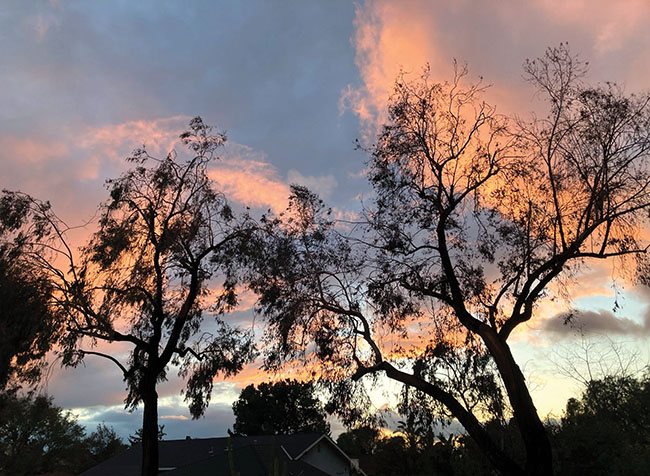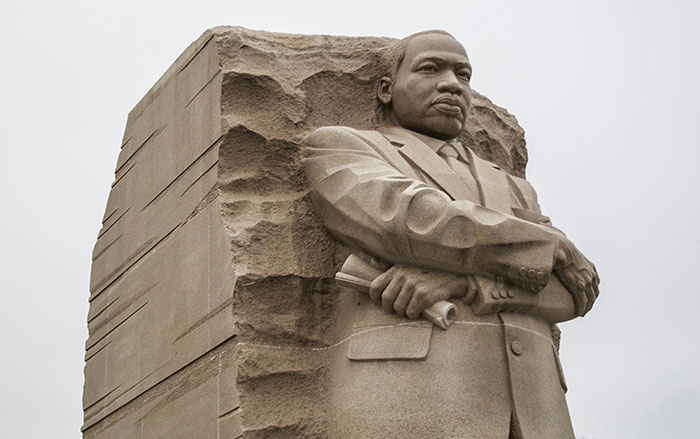Viewpoint: Claremont needs a heritage tree program

The last sunset photo of the red ironbark eucalyptus at 2235 N. Forbes Avenue the night before the tree crew from the city came to remove it in March. The tree’s absence is not entirely sad because now the cactus garden can be the desert oasis envisioned. COURIER photo/Steven Felschundneff
By Mark von Wodtke | Special to the Courier
Tree legacy
Homes, campuses, and Claremont’s public streets and parks should all have the benefit of heritage trees, which provide a living infrastructure for cleaner air and many other ecological amenities. Claremont has California Botanic Garden, the Claremont Wilderness Park, the Claremont Colleges campuses, the Village, and businesses and organizations that enhance our urban infrastructure. Our trees have a story to sustain. Our tree canopy consists of private and public trees that reflect our cultural heritage as the City of Trees and Ph.D.s.
Build upon this heritage
Indigenous people lived in California for thousands of years. Long before Claremont was incorporated, Native Americans had settlements in this mountain-rimmed basin. Indian Hill had artesian water, good places to hunt and gather foods, and natural materials for shelter. Indigenous people valued natural ecosystems and their tree legacy. Shade from native oaks, sycamores, and bays was appreciated. Native Americans were known for using sticks to plant beneficial native trees. They helped manage wildfire and gathered firewood for cooking and heating. The alluvial fan around Claremont had sustainable plant communities. They often hunted in the mountain canyons to avoid heat and avoid winter snow. These people lived in balance with the natural world.
In 1889, Claremont planted 250 street trees. One of our community’s first activities was to decide where to plant these trees and to nurture them. Over the years, Claremont developed an urban tree policy, working with volunteers, Sustainable Claremont, and other groups. We have a tree legacy for both public and private trees.
A new heritage tree program would serve to protect significant trees from damage and sustain their ecological value. Such a program would help balance clean air demands with our capacity to enhance the environment and reduce emissions. An urban canopy conserves energy, filters stormwater, improves air quality, removes carbon dioxide, and stores biomass which helps sustain our local ecosystem.
Such a program could stimulate Claremont residents and schoolchildren to sustain heritage trees. We can balance the capacity of our tree canopy to offset demands on the environment. We need to bring our ecosystem back into balance with natural processes. Our fossil fuel ecosystem has peaked in 150 years, and it is time to transition to clean renewable energy. By further protecting trees for the future, we can develop an urban infrastructure that will balance our local air quality and the health of the planet.
Claremont can refine its tree canopy program, administered by the city, to deal with public street trees and trees in parks. We should be sure we evaluate which trees to remove and which to protect, using geographic information systems to monitor Claremont’s public tree inventory. We can also work with other public entities, such as Caltrans and the public transit systems, to make good use of ways to filter air and help mitigate pollution. Owners of private property — homeowners, schools, campuses, and workplaces — should seek to have the city designate trees that are considered important to sustaining to our culture and air quality infrastructure. Private trees are a major part of our urban canopy. We should designate trees we want to protect on a long-term basis.
Initiating a legacy tree program
Claremont can seek funding from private, state, and federal sources to plant more urban trees, involving both property owners and the city. This is already being done with Claremont heritage building dedications. We need to protect this natural heritage and encourage more people to deal with the transitions needed to stifle climate change. Neighboring communities such as Pomona, La Verne, and San Dimas, as well as Los Angeles County have protected native trees such as oaks and sycamores. The South Coast Air Quality Management District needs to continue developing standards that meet the public’s health requirements.
Providing an ecological balance
A Claremont heritage tree program can extend public efforts to help protect trees on private property. Let’s nurture both public and private trees and reduce our energy footprint. Protecting canopy trees provides shade and improves air quality — locally protecting our health and tree legacy — while balancing our ecosystem and helping to sustain our planet.
Mark von Wodtke, FASLA, is a Fellow of the American Society of Landscape Architecture and Professor Emeritus of Landscape Architecture at Cal Poly Pomona.








0 Comments